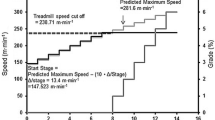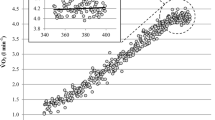Abstract
The purpose of this study was to (1) validate a new exercise protocol for accurate measurement of VO2max by obtention of a VO2max plateau for all subjects fit and unfit (2) test the hypothesis that VO2max plateau duration is not correlated with VO2max and (3) verify that limiting factors of VO2max plateau duration are different from those of VO2max amplitude. Therefore, 14 subjects performed two incremental cycling tests: (1) a classical incremental test (CIT) to determine VO2max, the power at VO2max (PVO2max) and at the lactate threshold (PLT) (2) a new incremental test (NIT) in which the power was decreased just after the subject reached VO2max. During both protocols, heart rate, stroke volume, cardiac output, the arterio-venous difference and the oxygen blood saturation were recorded. The results showed that, with the NIT, subject could maintain a long VO2max plateau (6 ± 3 min), even those who could not reach VO2max plateau at the end of CIT (n = 5). The VO2max plateau duration was not correlated with VO2max amplitude which was correlated with the power at SVmax (r = 0.888, p < 0.001). The VO2max plateau duration was correlated with the power decrease (W/s) during the VO2max plateau (r = −0.72, p = 0.003) but not with cardiac-related factors nor with PVO2max. In conclusion, these experiments showed that it was possible to get a long VO2max plateau at the end of NIT whatever the individual VO2max amplitude was. The limiting factor of VO2max duration was the power output.



Similar content being viewed by others
References
American college of sports medicine (2006) ACSM’s resource manual for guidelines for exercise testing and prescription, 5th edn. Lippincott Williams and Wilkins, Philadelphia
Astorino TA, White AC (2010) Assement of anaerobic power to verify VO2max attainement. Clin Physiol Funct Imaging 30:294–300
Astorino TA, Willey J, Kinnahan J, Larsson SM, Welch H, Dalleck LC (2005) Elucidating determinants of the plateau in oxygen consumption at VO2max. Br J Sports Med 39:655–660
Astrand PO, Saltin B (1961) Oxygen uptake during the first minutes of heavy muscular exercise. J Appl Physiol 16:971–976
Astrand PO, Rodahl K (1986) Textbook of work physiology, 3rd edn. McGraw-Hill, New York, pp 333–365
Bergh U, Ekblom B, Astrand PO (2000) Maximal oxygen uptake “classical” versus “contemporary” viewpoints. Med Sci Sports Exerc 32:85–88
Billat VL, Renoux JC, Pinoteau J, Petit B, Koralsztein JP (1994) Time to exhaustion at 100% of velocity at VO2max and modelling of the time-limit/velocity relationship in elite long distance runners. Eur J Appl Physiol 69:271–273
Billat VL, Blondel N, Berthoin S (1999) Determination of the velocity associated with the longest time to exhaustion at maximal oxygen uptake. Eur J Appl Physiol Occup Physiol 80:159–161
Billat VL, Slawinski J, Bocquet V, Demarle A, Lafitte L, Chassaing P, Koralsztein JP (2000) Intermittent runs at the velocity associated with maximal oxygen uptake enables subjects to remain at maximal oxygen uptake for a longer time than intense but submaximal runs. Eur J Appl Physiol 81:188–196
Borg GA (1982) Psychophysical bases of perceived exertion. Med Sci Sports Exerc 14:377–381
Christensen EH, Hedman R, Saltin B (1960) Intermittent and continuous running (A further contribution to the physiology of intermittent work). Acta Physiol Scand 50:269–286
Day JR, Rossiter HB, Coats EM, Skasick A, Whipp BJ (2003) The maximally attainable VO2 during exercise in humans: the peak versus maximum issue. J Appl Physiol 95:1901–1907
di Prampero PE (1989) Energetics of world records in human locomotion. In: Wieser W, Gnaiger E (eds) Energy transformations in cells and organisms. Thieme, Stuttgart, pp 248–253
di Prampero PE (1999) The concept of critical velocity: a brief analysis. Eur J Appl Physiol Occup Physiol 80:162–164
di Prampero PE (2003) Factors limiting maximal performance in humans. Eur J Appl Physiol 90:420–429
Doherty M, Nobbs L, Noakes TD (2003) Low frequency of the “plateau phenomenon” during maximal exercise in elite British athletes. Eur J Appl Physiol 89:619–623
Ekblom B (2009) Counterpoint: maximal oxygen uptake is not limited by a central nervous system governor. J Appl Physiol 106:339–341
Gaesser GA, Poole DC (1986) Lactate and ventilatory thresholds: disparity in time course of adaptations to training. J Appl Physiol 61:999–1004
Gibson A, Lambert MI, Hawley JA, Broomhead SA, Noakes TD (1999) Measurement of maximal oxygen uptake from two different laboratory protocols in runners and squash players. Med Sci Sports Exerc 31:1226–1229
Gledhill N, Cox D, Jamnik R (1994) Endurance athletes’ stroke volume does not plateau: major advantage os diastolic function. Med Sci Sports Exerc 26:1116–1121
Gordon D, Hopkins S, King C, Keiller D, Barnes RJ (2011) Incidence of the plateau at VO2max is dependent on the anaerobic capacity. Int J Sports Med 32:1–6
Hagberg JM, Mullin JP, Nagle FJ (1978) Oxygen consumption during constant-load exercise. J Appl Physiol 45:381–384
Hawkins MN, Raven PB, Snell PG, Stray-Gundersen J, Levine BD (2007) Maximal oxygen uptake as a parametric measure of cardiorespiratory capacity. Med Sci Sports Exerc 39:103–107
Hill AV, Lupton H (1923) Muscular exercise, lactic acid, and the supply and utilization of oxygen. Q J Med 16:135–171
Hill DW, Poole DC, Smith JC (2002) The relationship between power and the time to achieve VO2max. Med Sci Sports Exerc 34:709–714
Howley ET (2007) VO2max and the plateau—needed or not? Med Sci Sports Exerc 39:101–102
Howley ET, Bassett DR Jr, Welch HG (1995) Criteria for maximal oxygen uptake: review and commentary. Med Sci Sports Exerc 27:1292–1301
Jones AM, Vanhatalo A, Burnley M, Morton RH, Poole DC (2010) Critical Power: implications for determination of VO2max and exercise tolerance. Med Sci Sports Exerc 42:1876–1890
Katch VL, Sady SS, Freedson P (1982) Biological variability in maximum aerobic power. Med Sci Sports Exerc 14:21–25
Knight DR, Schaffartzik W, Poole DC, Hogan MC, Bebout DE, Wagner PD (1993) Effects of hyperoxia on maximal leg O2 supply and utilization in men. J Appl Physiol 75:2586–2594
Lacour JR, Messonnier L, Bourdin M (2007) The leveling-off of oxygen uptake is related to blood lactate accumulation. Retrospective study of 94 elite rowers. Eur J Appl Physiol 101:241–247
Levine DB (2008) VO2max: What do we know: and what do we still need to know? J Physiol 586:25–34
Lucía A, Rabadán M, Hoyos J, Hernández-Capilla M, Pérez M, San Juan AF, Earnest CP, Chicharro JL (2006) Frenquency of the VO2max plateau phenomenon in world-class cyclists. Int J Sports Med 27:984–992
Midgley AW, Bentley DJ, Luttikholt H, McNaughton LR, Millet GP (2008) Challenging a dogma of exercise physiology: does an incremental exercise test for valid VO2max determination really need to last between 8 and 12 minutes? Sports Med 38:441–447
Monod H, Scherrer J (1965) The work capacity of synergy muscular groups. Ergonomics 8:329–338
Niemelä K, Palatsi I, Linnaluoto M, Takkunen J (1980) Criteria of maximum oxygen uptake in progressive bicycle tests. Eur J Appl Physiol Occup Physiol 44:51–59
Poole DC, Ward SA, Gardner G, Whipp BJ (1988) A metabolic and respiratory profile for prolonged exercise in man. Ergonomics 31:1265–1279
Poole DC, Ward SA, Whipp BJ (1990) The effects of training on the metabolic and respiratory profile of high-intensity cycle ergometer exercise. Eur J Appl Physiol 59:421–429
Poole DC, Barstow TJ, McDonough P, Jones AM (2008) Control of oxygen uptake during exercise. Med Sci Sports Exerc 40:462–474
Shephard RJ (2009) Is the measurement of maximal oxygen intake passé? Br J Sports Med 43:83–85
Stoudemire NM, Wideman L, Pass KA, McGinnes CL, Gaesser GA, Weltman A (1996) The validity of regulating blood lactate concentration during running by ratings of perceived exertion. Med Sci Sports Exerc 28:490–495
Taylor HL, Buskirk E, Henschel A (1955) Maximal oxygen intake as an objective measure of cardio-respiratory performance. J Appl Physiol 8:73–80
Vanhatalo A, Poole DC, DiMenna FJ, Bailey SJ, Jones AM (2011) Muscle fiber recruitment and the slow component of O2 uptake: constant work rate versus all-out sprint exercise. Am J Physiol 300:700–707
Wagner PD (1999) New ideas on limitations to VO2max. Exerc Sport Sci Rev 28:10–14
Wasserman K, Hansen JE, Darryl YS, Casaburi R, Whipp JB (1999) Principles of exercise testing and interpretation, 3rd edn. Lippincott Williams and Wilkins, Philadelphia
Yoon BK, Kravitz L, Robergs R (2007) VO2max, protocol duration, and the VO2 plateau. Med Sci Sports Exerc 39:1186–1192
Zhou B, Conlee RK, Jensen R, Fellingham GW, George JD, Fisher AG (2001) Stroke volume does not plateau during graded exercise in elite male distance runners. Med Sci Sports Exerc 33:1849–1854
Author information
Authors and Affiliations
Corresponding author
Additional information
Communicated by David C. Poole.
Rights and permissions
About this article
Cite this article
Petot, H., Meilland, R., Le Moyec, L. et al. A new incremental test for VO2max accurate measurement by increasing VO2max plateau duration, allowing the investigation of its limiting factors. Eur J Appl Physiol 112, 2267–2276 (2012). https://doi.org/10.1007/s00421-011-2196-5
Received:
Accepted:
Published:
Issue Date:
DOI: https://doi.org/10.1007/s00421-011-2196-5




